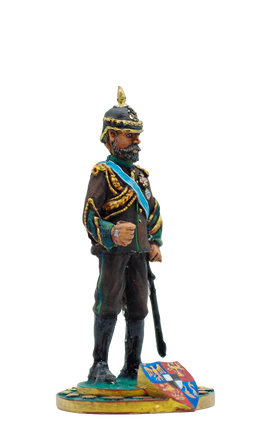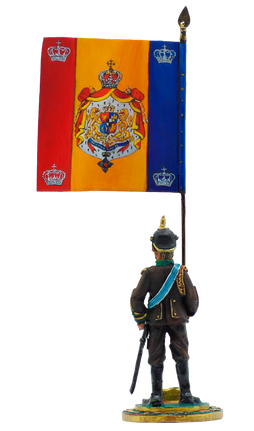
Ferdinand
Crown Prince of Romania
Ferdinand I (Ferdinand Viktor Albert Meinrad; 24 August 1865 – 20 July 1927), nicknamed Întregitorul ("the Unifier"), was King of Romania from 1914 until his death in 1927. Ferdinand was the second son of Leopold, Prince of Hohenzollern, and Infanta Antónia of Portugal, daughter of Ferdinand II of Portugal and Maria II of Portugal. His family was part of the Catholic branch of the Prussian royal family Hohenzollern. In 1889, Ferdinand became Crown Prince of the Kingdom of Romania, following the renunciation of his father and older brother to the rights of succession to the royal crown of Romania. From the moment he settled in Romania, he continued his military career, gaining a series of honorary commands and being promoted to the rank of corps general. He married in 1893 Princess Marie of Edinburgh, granddaughter of both Queen Victoria and Emperor Alexander II. Ferdinand became King of Romania on 10 October 1914, under the name Ferdinand I, following the death of his uncle, King Carol I. He ruled Romania during World War I, choosing to side with the Triple Entente against the Central Powers. This led to Kaiser Wilhelm II of Germany removing his name from the royal house of Hohenzollern. At the war's end, Romania emerged as a much-enlarged kingdom due to Bessarabia, Bukovina and Transylvania and parts of Banat, Crisana, and Maramures becoming part of the Kingdom of Romania in 1920, and Ferdinand was crowned king of "Greater Romania" in a grand

ceremony in 1922. In the years following the establishment of Greater Romania, Romanian society went through a series of major transformations, especially to the application of the agrarian reform and of the universal vote. In 1925, his eldest son, Prince Carol, gave up the rights of succession to the royal crown of Romania leading to a dynastic crisis, as the next prince in line of succession was Carol's 4-year-old son, Prince Michael. This led Ferdinand to remove Prince Carol's name from the royal house of Romania. Ferdinand died from cancer in 1927 and was succeeded by his grandson Michael under a regency formed by three people: Prince Nicholas of Romania, the younger brother of Prince Carol; patriarch Miron Cristea; and president of the Supreme Court of Justice Gheorghe Buzdugan.

Corp al Granicerilor. The history of the Granichary' corps in the Roman Principalities began in the first decades of the 19th century and for Transylvania even earlier in the 18th century. The name of Corps of Granichary appeared in 1834, during the period of the Organic Regulation, when it was created in Wallachia on the basis of a "Project on the guarding of the Danube and the border between Austria and Moldova". After the Union of the Principalities in 1859, Alexandru Ioan Cuza decided to unify the two Granicharys Corps according to the model of the Granicharys Corps in Wallachia until that time. Several reorganizations took place, many of them especially after the War of Independence - 1877, when the Granichary troops operated either in their own structures or included in other "arms" (such as the dorobant troops). The first important law concerning the establishment of the Granichary Corps appeared in March 1904 when these troops, besides the mission of guarding and surveillance of the borders, were also assigned customs and police duties.

Hohenzollern-Sigmaringen (German: Fürstentum Hohenzollern-Sigmaringen) was a principality in southwestern Germany. Its rulers belonged to the senior Swabian branch of the House of Hohenzollern. The senior Swabian branch is less well known to history than the junior Franconian line, the latter of which became Burgraves of Nuremberg and later ruled Brandenburg and Prussia, and the German Empire. The County of Hohenzollern-Sigmaringen was created in 1576, upon the partition of the County of Hohenzollern, a fief of the Holy Roman Empire. When the last count of Hohenzollern, Karl I (1512–1579) died, the territory was divided among his three sons. The princes of Hohenzollern-Sigmaringen ruled over a small principality in south-western Germany, with a seat at Sigmaringen Castle. Unlike the Hohenzollerns of Brandenburg-Prussia, the Hohenzollerns of Sigmaringen remained Roman Catholic, along with their cousins of Hohenzollern-Hechingen (the senior line of the Swabian branch of the House of Hohenzollern) and Hohenzollern-Haigerloch. The principality became a sovereign state in 1815 after the abolition of the Holy Roman Empire in 1806 and an
independent realm following the Napoleonic Wars in 1815. Its ruler, Charles, was deposed in the revolutions of 1848. His son, Karl Anton, succeeded him, and turned to Prussia for aid. Prussian troops arrived in August 1849, and in a treaty signed in December Hohenzollern-Sigmaringen was annexed by Prussia, effective in March 1850. The annexation of their state did not, however, mean the end of the importance of the House of Hohenzollern-Sigmaringen. The last prince, Karl Anton, served as Minister President of Prussia from 1858 to 1861. Karl Anton's second son, Karl Eitel of Hohenzollern-Sigmaringen became prince (1866–1881) and then King of Romania, under the name Carol (reigned 1881–1914). The house remained on the throne until the end of the Romanian monarchy in 1947. The last King of Romania, Michael, died on 5 December 2017.

Royal standard of the King. According to the laws of 1867 and 1872, the princely (later royal) flag was identical to that of the army, bearing the coat of arms in the centre. However, a slightly different design was adopted in their making, giving the yellow colour double the width of the red and blue and adopting a 1:1 canvas ratio. A silver royal crown was sewn into the corners of the flag.
Awards: Sash and star of the Order of the Crown of Romania (Ordinul Coroana României), Star of the Order of the Star of Romania (Ordinul Steaua României).










